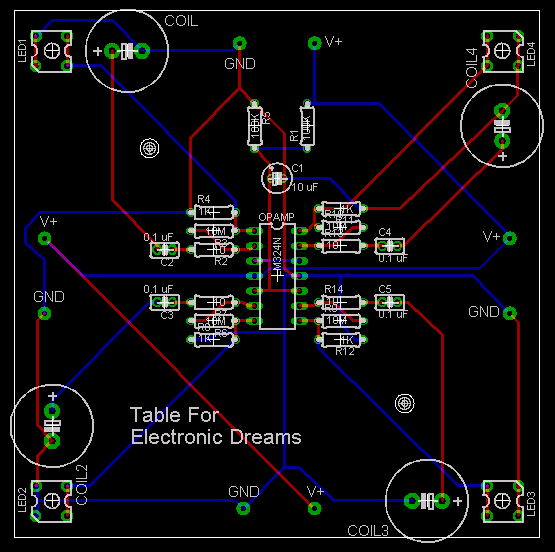another prototype
two videos, one of my cellphone receiving a call, another with iPhone. I forgot to take stills.
« February 2008 | Main | April 2008 »
two videos, one of my cellphone receiving a call, another with iPhone. I forgot to take stills.
Found a cheap(er) source for telephone coils. Ordered two to see if they worked, they work great! So I ordered 60. Actually the cheaper ones are better because the casing comes off very easily... I was struggling to remove the casing on the Radioshack telephone coil.
Later the same day inductor coils from Electronic Goldmine arrived. I had forgotten about these! Haven't tested yet... but I have working coils.... should be worth testing anyway.

designed a board using Eagle. Sent it to Barebones PCB to test. Due to arrive Tuesday. Hopefully it will work fine!
I also ordered all the components from Digikey and white LEDs. I ordered so many things my credit card company called me to make sure I wasn't a victim of identity theft!
PARTS LIST
15 LM324
15 14-pin sockets
60 980mw7c white LED
60 induction coil
60 10 resistors
60 10M resistors
60 1K resistors
30 100K resistors
15 10uF capacitors
60 0.1uF capacitors
1/4 inch translucent white acrylic 33" x 21"
1/4 inch clear acrylic 33" x 21"
aluminum u-channel
new dimensions for table
pitch: 3"
33" x 21" --> golden ratio!
10 x 6 = 60
60 / 4 = 15 LM324
I am using white piranha LEDs.
I experimented with different acrylics today. a translucent white from Canal Plastic created a very nice effect- the circuit was completely hidden and it diffused the light very well. The distance between the LED and acrylic makes a big difference in how big the halo is.
I was also inspired by something I saw in the Taschen book Design for the 21st Century called the Tattoo Table, but I can't find it online [remember to look this up]. It was a glass table with some pattern etched in it, so that when light shone on it it projected those patterns onto the floor.
I am thinking now the design of the table can be very simple. The circuits will be sandwiched between two sheets of acrylic. perhaps the bottom one could be clear.

video of sensor behind acrylic responding to cellphone
I talked to the indispensable Raphael Zollinger about construction details. He built furniture for a few years, and so his advice was invaluable. This is a part of the project I was very intimidated about, but he suggested a method which will be simple, elegant and easy to construct.
I also went to Material Connexion on Tuesday, where they were very nice to me. I was really impressed with the privacy glass, which when you run current through becomes clear. There was also ink containing DNA, fluid which harden/softens in response to magnetic fields (is this ferrofluid?), special polymers for LEDs, photochromic dyes which respond to UV light, screen printable electro-luminescent ink.... some of this I need to investigate further, just for my own curiosity. I will try to get samples of the printable electro-luminescent ink. I don't think I'll be using it at this point but there is always a possibility.
Other issues:
Feedback - It turns out the LM324 doesn't have feedback issues. This is a relief in a way. Experimented by trying to create distortion by linking two op amps, but this didn't work. I mostly just got a steady light. But when I just had the single circuit working, I noticed it began blinking in weird ways at one point for no apparent reason. So perhaps there would be unintended effects.
I got the impression from my midterm presentation that some people thought just a revealing of EM wasn't really exciting enough, but I think it may actually be very expressive. The cellphone blinks, and when it receives a call suddenly splashes out. Turning external harddrives on and off would excite more LEDs. I hope that it will actually show something about the functioning of the devices.
The induction coil - the Radioshack telephone pickup retails at $8! it works great, but if I need 60 of them thats just too expensive. I ordered a few induction coils off Electronic Goldmine, hopefully there will be at least one which works great.But I have no idea. I need to find a good, cheap coil to use. I don't know why the excessive cost did not occur to me earlier. I guess I was just trying to get the damn circuit to work. Now I am seeing the entire design more or less together, which is good.
I will also try hand-wrapping coils.... I should probably try this anyway, see how wire gauge, wrapping, etc. affect what frequencies are detected... there is still a lot about the induction process which is just a mystery. I am also trying to cut open the pickup to see what the inside coil looks like, so I can imitate it. A lot of my project seems to be involving trying to reverse-engineer Radioshack gear.
Other things I need to do: